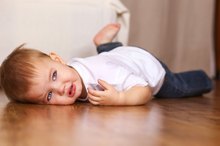Sleepwalking in Teens
Finding your child sleepwalking can be an unsettling sight. Sleepwalkers might try to exit the house or even urinate in an inappropriate place. Furthermore, your sleepwalking teen might appear frantic, flailing about or trying to lash out when restrained 1. Even his voice might be altered, notes Rafael Pelayo, M.D., a pediatric neurologist and director of the pediatric sleep service at Stanford University in an article on Kids Health. While it might be frightening to witness, Pelayo says sleepwalking is rather common among adolescents.
Adolescent Sleepwalking
According to Pelayo, sleepwalking peaks during growth spurts, so children are particularly susceptible to nocturnal roaming. Sleepwalking typically begins during adolescence and continues into the teen years, but about half who do sleepwalk stop before adulthood, Pelayo notes 1. Children often sleepwalk within an hour or two of falling asleep, and they might walk around for a few seconds or up to 30 minutes. Sleepwalking most often occurs in stages three and four of rapid eye movement sleep, or REM. This is when it's hardest to awaken someone. If you are able to awaken your sleepwalking child, he will likely be disoriented and groggy. However, Pelayo does not recommend trying to awaken a sleepwalker.
- According to Pelayo, sleepwalking peaks during growth spurts, so children are particularly susceptible to nocturnal roaming.
- Sleepwalking typically begins during adolescence and continues into the teen years, but about half who do sleepwalk stop before adulthood, Pelayo notes 1.
Causes and Behaviors
OCD Symptoms in Toddlers
Learn More
According to Pelayo, sleepwalking can be caused by sleep deprivation, sleeping in unfamiliar surroundings, alcohol and other drugs. Other triggers include illness or fever and stress. Pelayo notes that teenagers who have a family history of sleep disorders, and those who had frequent night terrors as children, are predisposed to sleepwalking. Sometimes a sleepwalking teen will have has his eyes open, but there are obvious signs that he is not conscious, such as sleep talking, and dazed or clumsy mannerisms. He might not respond when spoken to or be hard to wake up. Also, sometimes sleepwalkers make repetitive motions like rubbing their eyes.
- According to Pelayo, sleepwalking can be caused by sleep deprivation, sleeping in unfamiliar surroundings, alcohol and other drugs.
- Sometimes a sleepwalking teen will have has his eyes open, but there are obvious signs that he is not conscious, such as sleep talking, and dazed or clumsy mannerisms.
Take Precautions
Sleepwalking is not harmful, but it can be dangerous. Pelayo notes that anything you can do while conscious, your child can do while sleepwalking, including turning on power tools. Take precautions to ensure that your teen won't injure himself during an episode. If you see your child sleepwalking, avoid frightening him by directing him back to bed rather than try to wake him. Lock windows and doors in case your child tries to exit the house, removing sharp or breakable objects from the area near his bed, and installing safety gates outside of his room or at the top of any staircases.
- Sleepwalking is not harmful, but it can be dangerous.
- If you see your child sleepwalking, avoid frightening him by directing him back to bed rather than try to wake him.
Other Concerns
Children With Nosebleeds at Night
Learn More
While sleepwalking is fairly common in adolescence, it might signal something more significant than stress or lack of sleep. Sleepwalking coud be a sign of sleep apnea, bed wetting or night terrors. Furthermore, Pelayo notes that partial complex seizures look similar to sleepwalking. These can occur at any point during the REM cycle. Pelayo warns parents to be concerned about an older teen who sleepwalks for the first time. “Such a patient should receive a sleep-deprived EEG to rule out a seizure disorder,” he says in an article on the website Kids Health.
- While sleepwalking is fairly common in adolescence, it might signal something more significant than stress or lack of sleep.
- Such a patient should receive a sleep-deprived EEG to rule out a seizure disorder,” he says in an article on the website Kids Health.
Related Articles
References
- Kids Health: About Sleepwalking
- Entrepreneur; Adolescent Sleepwalkers Are Often Agitated (Clinical Rounds); Betsy Bates; 2007
- American Academy of Sleep. Adult sleepwalking is a serious condition that impacts health-related quality of life.
- American Sleep Apnea Association. Children’s Sleep Apnea.
- Bharadwaj R and Kumar S. Somnambulism: Diagnosis and treatment. Indian J Psychiatry. 49(2): 123–125. DOI: 10.4103/0019-5545.33261
- Cleveland Clinic. Sleepwalking.
- Frank NC, Spirito A, Stark L, Owens-Stively J. The use of scheduled awakenings to eliminate childhood sleepwalking. Current neurology and neuroscience reports.
- Guilleminault C, Kirisoglu C, Bao G, et al. Adult chronic sleepwalking and its treatment based on polysomnography. Brain. 128(Pt 5):1062-9. DOI: 10.1093/brain/awh481
- Mayo Clinic. Sleepwalking.
- Mayo Clinic. Polysomnography (sleep study).
- National Sleep Foundation. Sleepwalking: Why It Happens.
Writer Bio
Monica Crowe has written professionally since 2008. She was a reporter for the "Ruston Daily Leader" and editor of "Living Well" magazine. Crowe is the recipient of a first-place Louisiana-Mississippi Associated Press award. She studied at Louisiana Tech University and is now pursuing a certification from the National Academy of Sports Medicine.









